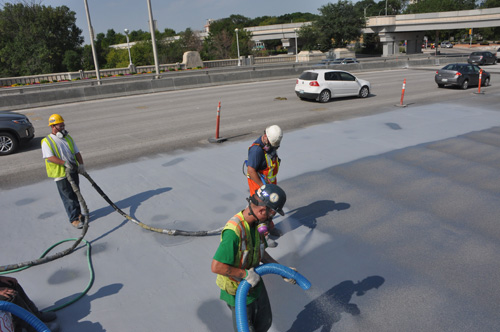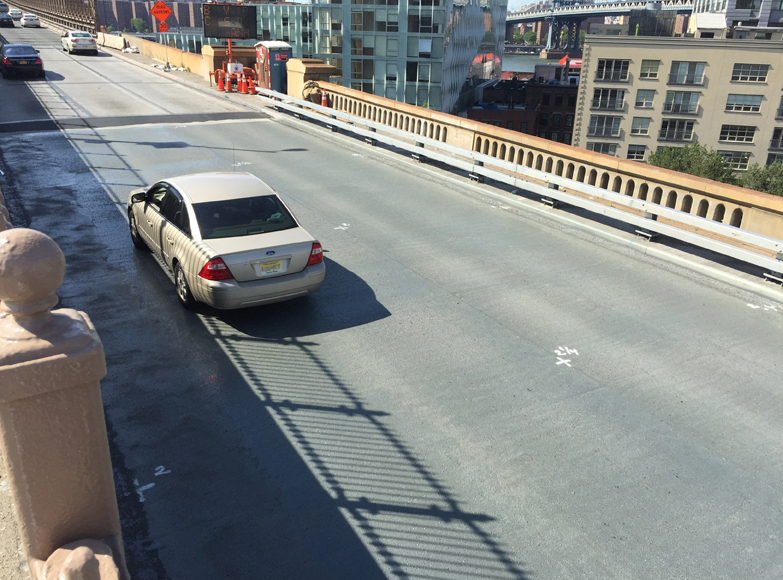A recent 60 Minutes TV broadcast, “Falling Apart,” explains that “America’s roads, bridges, airports, and rail lines are outdated and need to be fixed” due to decades of neglect. The broadcast goes on to state that “nearly 70,000 bridges in America—one out of every nine—is now considered to be structurally deficient” and that according to the American Society of Civil Engineers (ASCE), “32% of the major roads in America are now in poor condition and in need of major repairs.”
The problem with much of America’s infrastructure is that it has outlived its intended service life, and coating failure has led to significant degradation of structural elements, including rebar corrosion and crumbling concrete. As an alternative to more traditional materials such as sheet goods and sacrificial short-term liquid sealants, new high-performance, spray-applied waterproofing alternatives are being used to effectively protect and maintain critical infrastructure such as bridges, highways, railroads, tunnels, parking decks, airport terminals, and entrance/exit ramps. These waterproofing products are seamless, rugged, fast curing, impervious to water, able to bridge cracks, and capable of lasting decades without extensive maintenance.
“Spray-applied waterproofing now accounts for over 50% of the membranes applied to our bridges,” says Alexander Bardow, P.E., state bridge engineer with the Massachusetts Department of Transportation (MassDOT), as well as a member of the American Association of State Highway and Transportation Officials (AASHTO) Subcommittee on Bridges and Structures, and past president of the Boston Society of Civil Engineers Section of ASCE. “What drove us to spray-applied waterproofing is its enhanced durability, bonding to concrete, and crack-bridging ability,” he says. According to Bardow, who oversees and helps to prioritize work on 5,000 bridges that receive federal funds for MassDOT, “If cracks form due to deck deterioration or traffic loading, then water gets into those cracks and the concrete matrix. The [underlying] membrane must be pliable enough to accommodate these cracks without failing.”

While traditional methods of waterproofing such as emulsions, sheet goods, and non-elastomeric coatings like epoxies and paints have long been used, they must continually be inspected and maintained over time. Additionally, non-elastomeric coatings do not have the elasticity to bridge cracks, and are moisture resistant rather than waterproof. In past decades, Bardow says, MassDOT utilized a mopped emulsion reinforced with fiberglass fabric for bridge decks, then later turned to sheet goods. “Our experience showed that reinforced emulsion was not a good deck waterproofing system because it debonded,” he notes. “Water could get underneath it and into the deck. We turned to prefabricated sheet-applied membranes. These were easy to apply, but we wanted more durability. Spray-applied waterproofing membrane is the next step after sheet membrane,” Bardow continues. “It gives us better performance and has measurable performance characteristics that we can count on for extended deck life.” He comments that MassDOT expects spray-applied waterproofing membranes to last about 30 to 50 years. “We would still repave and resurface the asphalt overlay, but would not need to do anything to maintain the underlying waterproof membrane during that time,” he adds.
Since crack bridging is critical for ensuring long-term waterproofing protection, many bridge owners require the ASTM C-13051 crack-bridging test for liquid-applied membranes. For the test, the membrane system is applied across two concrete blocks with matching faces. The test sample is then brought down to –15 °F (–26.1 °C) for 24 h to stabilize at this temperature. The test requires the two blocks be pulled apart at a rate of 0.125 in/hr (3.175 mm/h) to a maximum opening of 0.125 in, and then closed to a 0.0-in gap at the same speed. The test fixture must maintain the sample at the –15 °F temperature throughout the required ten cycles of testing.

Some manufacturers conduct additional cycles to further test the limits of their products. For instance, Bridge Deck Membrane† by Bridge Preservation, LLC (Kansas City, Kansas) passes the ASTM C-1305 test after 40 cycles.
Some spray-applied elastomer waterproofing systems have linear thermal expansion coefficients similar to concrete and steel, the most common building materials for bridges. This physical property is an important prerequisite to ensure success when membranes are used as a composite with layers of asphalt. “Instead of traditionally sealing bridge decks every five years or so, they could be spray-applied waterproofed with materials…that can last five decades or more,” says Traci Micucci, president of Eastern Bridge Works, a waterproofing contractor based in Poughkeepsie, New York. “That would eliminate repeatedly tearing up the asphalt overlay, resealing the deck, and repaving it, plus all the required lane closures. It would stop rebar corrosion and concrete spalling in decks to keep infrastructure safely operating.”
These spray-applied membranes can be sprayed horizontally, vertically, and overhead at any thickness, as well as a specified thickness in one continuous application. Spray-applied waterproofing can also be robotically applied with greater speed and consistency than other materials. “By robot, we can consistently spray-apply waterproof over 10,000 ft2 [929 m2] of deck per day … at 80 to 85 mils [2 to 2.2 mm] on any surface,” says Ted Predki, chief estimator and project manager at Pine Waterproofing and Sealant. “It’s easy to high-build spray it in one coating.” As a waterproofing contractor, Predki also prefers the spray-applied waterproofing approach for its fast set and curing times. “[The waterproofing] can set in 10 seconds so you can walk on it,” says Predki. The company installed nearly 7,000 ft2 (650 m2) of spray-applied waterproofing on the Metra Bridge over US 45 in Orland Park, Illinois, which was originally constructed in 1940 for the Wabash Railway Co.
Another project in downtown Chicago, Illinois that was recently completed by the waterproofing contractor involved the application of 65,000 ft2 (6,039 m2) of spray-applied waterproofing to a surface that needed to be returned to service as quickly as possible. The concrete had an extremely rough surface, but the material was still able to achieve a superior bond. The contractor was able to install over 30,000 ft2 (2,787 m2) of 80-mil thick waterproofing, and a 40-mil (1-mm) thick top coat with aggregate within seven days, and finish the job within four weeks.
For critical, high-traffic highway and rail bridges, the speed of spray-applied waterproofing installation and return to service is a particular advantage as it minimizes downtime. Some waterproofing products can accept ballast, temporary traffic, other trades, or asphalt overlays one hour after application. To further illustrate the importance of installation speed, many in the industry are utilizing spray-applied waterproofing as a standard material for accelerated bridge construction. This process uses prefabricated bridge elements and systems, such as composite decks manufactured off-site, which are installed with closure pours and then appropriately waterproofed. This expedites the project, improves quality, reduces traffic impact, and lowers total life-cycle costs.
Bardow says that a spray-applied membrane is standard for accelerated bridge construction for MassDOT projects. “With the large number of closure pours we do, we were also concerned about effectively waterproofing them so water intrusion does not become a problem over time. When we did the Metra Fast 14 project, we had to complete a bridge project in essentially one weekend,” he explains. “Within that time, we had to demolish the existing bridge, set prefabricated bridge units for the new bridge, do all the closure pours, have the concrete set, then come back to spray-apply a waterproofing membrane. The contractor accomplished this, and the speed of the spray-applied membrane installation was an important factor in meeting the accelerated deadline.”
For highway bridge projects that involve complicated staging and traffic management, some spray-applied waterproofing systems with an aggregate top coat can be used as a temporary driving surface for up to two weeks. This allows large areas of waterproofing to be applied prior to paving, and reduces the number of cold joints for more long-term durable wear. The aggregate top coat also enhances the bond between the membrane and asphalt, adding further long-term performance to the finished system.
In addition to the durable and cost-effective protection that spray-applied waterproofing provides, it also opens the door to complementary technologies. Bridge joints—typical locations that develop leaks—can now be completely waterproofed with spray-applied technology. Flexible expansion joint systems offer seamless waterproofing protection for joint openings. When used in conjunction with spray-applied waterproofing membranes, these expansion joints form a high-strength chemical bond that creates a single, monolithic layer of waterproofing across both the joints and bridge deck.
“With new spray-applied waterproofing technology designed to reliably last decades without ongoing maintenance, civil and structural engineers have a valuable new tool that can help them cost-effectively maintain critical infrastructure while minimizing downtime,” says Micucci.
Railroads are also turning to spray-applied waterproofing systems because of their enhanced durability and long-term performance. The “2015 Manual for Railway Engineering” (Chapter 8, Part 29)2 includes guidelines for spray-applied membranes.
Source: Bridge Preservation, LLC. Contact Doug Commette—e-mail: Ddoug@versaflex.com.
References
1 ASTM C130 –08, “Standard Test Method for Crack Bridging Ability of Liquid-Applied Waterproofing Membrane” (West Conshohocken, PA: ASTM International, 2008).
2 “2015 Manual for Railway Engineering” (Lanham, MD: AREMA, 2015).
†Trade name.